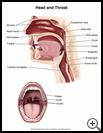
Tonsil and Adenoid Surgery
What is tonsil and adenoid surgery?
Surgical removal of the tonsils and adenoids (known as a T&A) is one of the most common operations performed on children in the U.S. Only 2% or 3% of children, however, have adequate medical reasons for this procedure. Never pressure for surgery unless it has proven benefits.
The tonsils are not just some worthless pieces of tissue that block our view of the throat. They have a purpose. They produce antibodies that fight nose and throat infections. They confine the infection to the throat, rather than allowing it to spread to the neck or bloodstream.
What are the risks of surgery?
T&A procedures are not without risk. Under ideal conditions, the death rate is 1 child per 250,000 operations. Approximately 4% of children bleed on the fifth to eighth day after surgery. A few of these children may need a blood transfusion or additional surgery. All children experience throat discomfort for several days. Some children whose speech was previously normal develop hypernasal speech because the soft palate no longer completely closes off the nose from the throat.
When is surgery necessary?
Sometimes the tonsils and/or adenoids need to come out. But the benefits must outweigh the risks. Your provider will decide if the tonsils, adenoids, or both need to be removed. All of the following are valid reasons for evaluation.
- Persistent mouth-breathing
Temporary mouth-breathing during colds or hay fever is common. Continued daily mouth-breathing is less common and deserves an evaluation to see if it is due to large adenoids. The open-mouth appearance results in teasing, and the mouth-breathing itself leads to changes in the facial bone structure (including an overbite that usually requires orthodontics). Mouth-breathing also causes a dry mouth and the lack of saliva increases the risk for tooth decay.
- Abnormal speech
The speech can be muffled by large tonsils or made hyponasal (no nasal resonance) by large adenoids. Although other causes are possible, an evaluation is in order.
- Severe snoring and obstructive sleep apnea
Snoring can have several causes. If snoring occurs every night and enlarged adenoids are the cause, they should be removed. In severe cases, the loud snoring is associated with retractions (pulling in of the spaces between the ribs), choking, gasping for breath, and interruptions of breathing. This is called obstructive sleep apnea.
- Heart failure
Rarely, large tonsils and adenoids interfere so much with breathing that blood oxygen is reduced and the right side of the heart goes into failure. Children with this condition are short of breath, have limited exercise tolerance, and have a rapid pulse.
- Persistent swallowing difficulties
During a throat infection, the tonsils may temporarily swell enough to cause swallowing problems. Some children refuse meats because they are difficult to swallow. Some children refuse all solid foods. If the problem is persistent and the tonsils are touching each other, an evaluation is needed. This problem more often occurs in children with a small mouth.
- Recurrent abscess (deep infection) of the tonsil
Your child's provider can check this.
- Recurrent abscess of a lymph node draining the tonsil
Your child's provider can check this.
- Suspected tumor of the tonsil
These rare tumors cause one tonsil to be much larger than the other. The tonsil is also quite firm to the touch, and usually enlarged lymph nodes are found on the same side of the neck.
When is surgery not necessary?
Some T&As are performed for unwarranted reasons.
- Large tonsils
Large tonsils do not mean "bad" tonsils or infected tonsils. The tonsils are normally large during childhood. They can't be "too large" unless they touch each other or interfere with function. The peak size is reached between 8 and 12 years of age. Thereafter, they spontaneously shrink in size each year, as do all of the body's lymph tissues.
- Recurrent colds and viral sore throats
Several studies have shown that T&As do not decrease the frequency of viral upper respiratory infections (URIs). These URIs are unavoidable. Eventually your child develops immunity to these viruses and experiences fewer colds per year.
- Recurrent strep throats
Studies have shown that a child does not have fewer streptococcal infections of the throat after the tonsils are removed unless the child experiences 7 or more strep infections per year (a rare occurrence). For children with 7 or more proven strep throat infections per year, some healthcare providers recommend daily penicillin for 6 months instead of a T&A, since penicillin can almost always get rid of the strep bacteria from the tonsils. Being a carrier of strep (which causes no symptoms and is harmless and not contagious) is also not a reason for doing a T&A.
- Recurrent ear infections
Several studies have shown that removal of the adenoids will not open the eustachian tube and decrease the frequency of ear infections or fluid in the middle ear. The exceptions are children who also have persistent nasal obstruction and mouth-breathing due to large adenoids. Persistent middle-ear fluid generally responds to the insertion of ventilation tubes in the eardrum without the need to remove the adenoids.
- School absence
If your child misses school for vague reasons (including sore throats), removing the tonsils will not improve attendance.
- Miscellaneous conditions
A T&A will not help a poor appetite, hay fever, asthma, or bad breath.
When should I call my child's healthcare provider?
Call during office hours if:
- You think your child has a valid need for a T&A.
- You have other concerns or questions.
Last modified: 2010-06-04
Last reviewed: 2011-06-06

